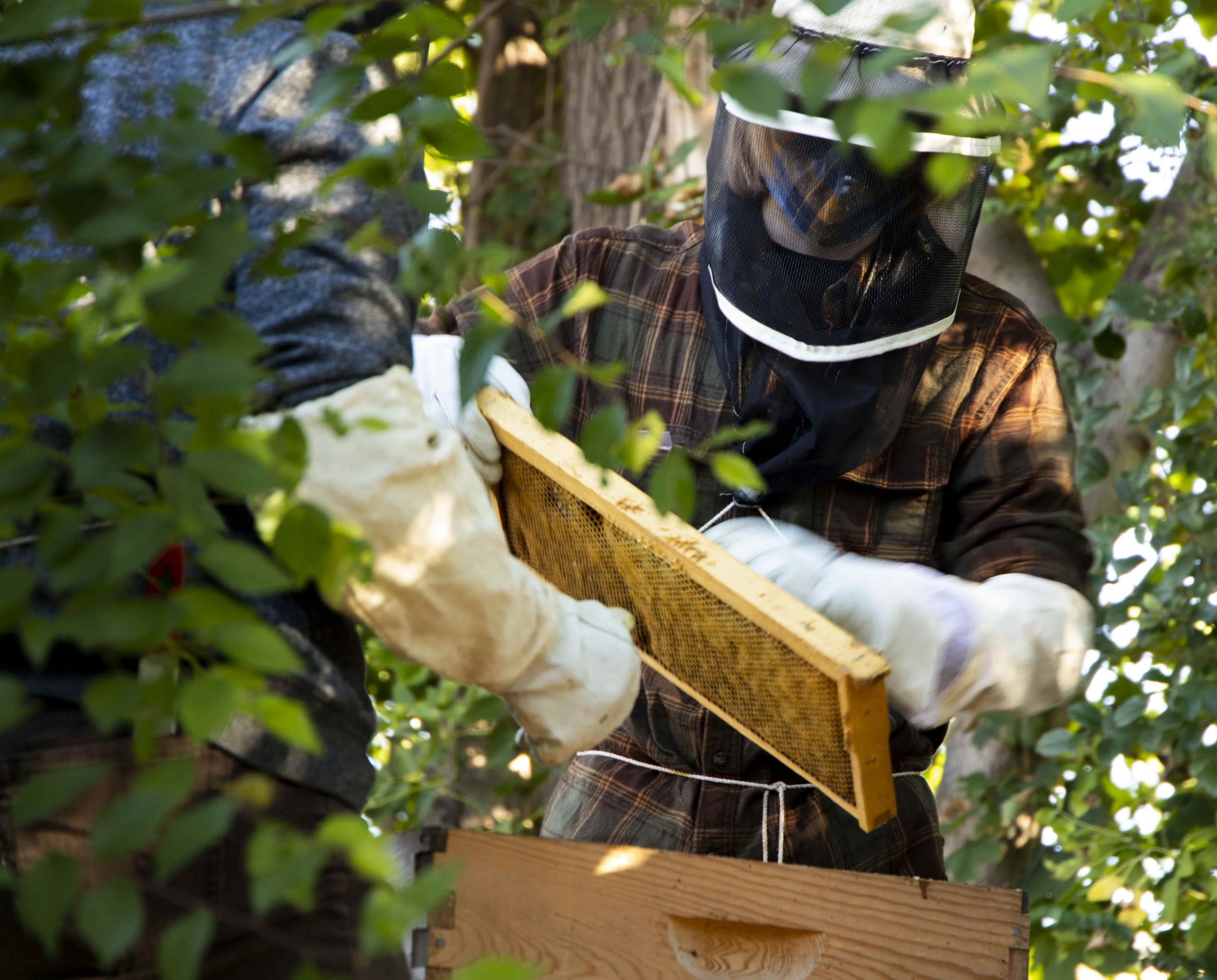A glimpse into the lives of Southeast Michigan’s honeybees

Volunteers at the Ypsilanti Food Co-Op inspect frames of honeycomb. Brenda Anderson | Washtenaw Voice
by ELINOR EPPERSON
Contributor
Sweater weather is here, which means beekeepers across Michigan are preparing their hives for winter. On a chilly Sunday morning, Connor Harlow carefully removes honey-filled frames from a hive in an alley in Depot Town. Smoke wafts around the hive as bees dozily flit around.
“Everyone really seems to enjoy them,” said Harlow. Harlow also mentioned that a lot of people don’t realize the hives are even there, as they are well-hidden in the alley.
The Co-op is focused on raising “Michigan-adapted survivor honeybees,” meaning bees that have survived the winter in Michigan. The Co-op also harvests honey to sell from the beehives. Harlow has been volunteering as a beekeeper for five years; he learned the trade at WCC while studying environmental science.
“Everyone’s got their own little nuance to how they [keep bees],” said Thomas Achatz, a part-time instructor of mathematics at WCC. He has been beekeeping on and off since 1992. Achatz keeps his bees on a farm near his house in Livingston County.
“There’s so much to learn from bees,” said Achatz.
“Reading” the Bees
A good beekeeper “[tries] to be minimally invasive,” said Harlow. A couple of times a week, he checks the bees for mites and confirms they have enough space to build honeycombs. He describes his job as “creating space for the bees to exist” and “letting them live.”
Achatz checks his bees every couple of weeks. He looks for signs of wax moths, mites, and other pests. He wants to know if the queen is laying eggs, if the workers fill the comb with nectar, make honey, and look healthy.
Achatz isn’t afraid of getting stung but wears a suit anyway.
“They’re not interested in stinging,” said Achatz. “When you get used to handling the bees, you can tell they have moods.” Achatz hasn’t been stung by his honeybees in three years and admits that “when I have gotten stung, it’s been my fault.”
Harlow said he tried being “one with the bees” when he started beekeeping. “But after 20 stings,” including some to the face, “I was done with that.”
Adapting to challenges
Honeybees aren’t going extinct, said Ana Heck, an educator at the Michigan State University Apiculture Extension. “Apiculture” is another word for beekeeping; the Apiculture Extension raises honeybees for research and education purposes. On her own time, Heck runs a beekeeping business with her partner called Beehavior Ranch.
“The overall number of [honeybee] colonies in the United States has stayed stable,” Heck said. However, it is “harder for beekeepers to keep [their] colonies healthy” these days. According to Bee Informed Partnership, a nonprofit that works with beekeepers to improve colony health, half of Michigan’s honeybee colonies did not survive the 2020-2021 winter.
Bees that have survived the winter benefit the wider bee population. One of the Co-op’s hives is preparing for its second overwinter. Harlow is excited to see how the colony does.
“Bees are incredibly genetically adaptive,” says Harlow. A hive that survives the winter can produce newly adapted bees in as little as three months. These bees will be “hardier” and better equipped to survive whatever they encountered that winter – unusual cold, food supply problems, or infection from bacteria, viruses, or parasites.
Lots of work goes into making sure the honeybee population remains stable. Harlow and Achatz are no strangers to the challenges honeybees face while preparing for winter.
While Harlow’s bees have been trucking along, Achatz’s haven’t been doing as well. None of his bees from last year survived the winter, and the heavy rain this year made it difficult for his new hives to thrive.
Bees must also contend with human landscaping. Heck said that pesticides can have “sublethal” effects on bees, including shortening workers’ lifespans and impairing their memory.
Another prevalent threat to honeybees in southeast Michigan is the varroa mite. Mites feed on the bee larvae, creating malformed and unhealthy bees. Harlow said they spread “incredibly quickly” and are “hard to control” once they have infested a hive. Mites can be a deciding factor in whether a bee colony makes it through the winter, according to Heck.
Preparing for winter
Around September or October, Harlow begins harvesting honey. The Co-op usually nets three to five gallons of honey per hive and leaves the rest for the bees to sustain themselves over the winter. Harlow administers a final treatment of organic acids to control any mites and leaves the rest to the bees.
Harlow, Heck, and Achatz all emphasize that bees are very active during the winter, contrary to popular belief. A typical winter day for a honeybee worker lasts 15 hours and is spent eating sugar, tending the brood, and cleaning the hive.
“Bees are very well adapted to surviving cold temperatures,” said Heck. Honeybees form a cluster inside the hive to generate heat, with the queen at the center.
Harlow mostly leaves the bees to their own devices, only touching the box to send some sugar water in to supplement the bees’ honey supply. Achatz leaves his bees alone throughout the winter. He usually wraps the hive to insulate it further but wonders if he needs to try something different this year. He won’t be taking any honey from his bees, as they haven’t produced much.
“The best way to help bees”
Attendees to Heck’s apiculture seminars often ask how they can help “save the bees.” Heck advocates planting more flowers, including flowers that bloom at different times of the year.
Achatz echoes these sentiments. He is also concerned about how much weedkiller and pesticides he sees other homeowners using to cultivate their lawns.
“My neighbors probably think I’m crazy,” said Achatz. He lets his lawn grow dandelions and other plants usually considered “weeds” because they benefit pollinators, including honeybees.
Harlow suggests maintaining a fresh source of water outdoors, such as a birdbath, to help local bees hydrate. He points out something humans and bees have in common – we should all “eat more honey, plant more flowers [and] drink more water.”


